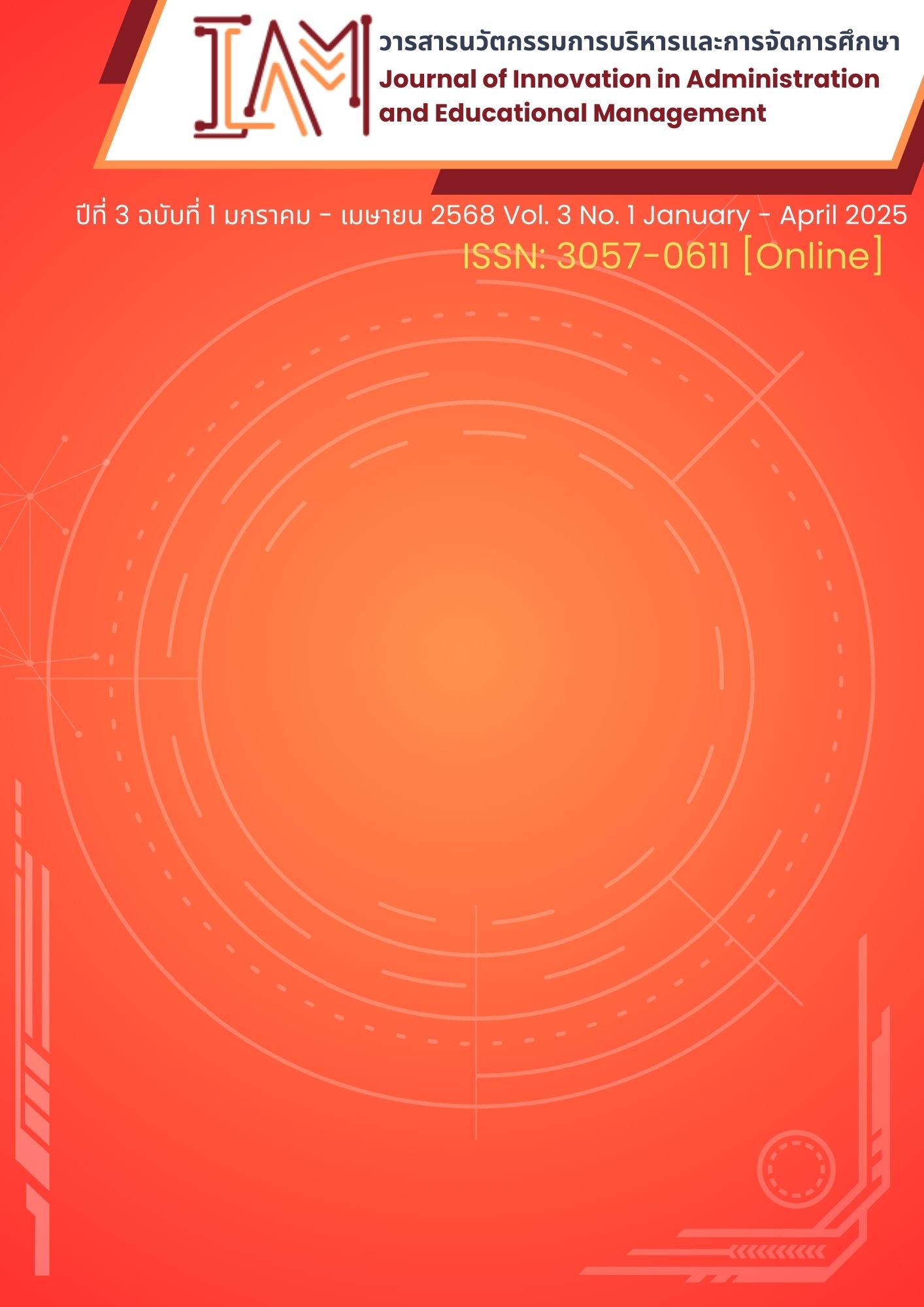การจัดกลุ่มผู้เรียนอัจฉริยะด้วย “เอไอ แอลแทร์ สตูดิโอ เคมีล” ตัวช่วยสำหรับครูยุคดิจิทัล
คำสำคัญ:
จัดกลุ่มผู้เรียนอัจฉริยะ, เอไอ แอลแทร์ สตูดิโอ เคมีล, ครูยุคดิจิทัลบทคัดย่อ
บทความวิชาการนี้มีวัตถุประสงค์เพื่อแนะนำการจัดกลุ่มผู้เรียนอัจฉริยะด้วยเอไอโดยใช้เอไอ แอลแทร์ สตูดิโอ เคมีล (Altair Studio and K-means) นับเป็นเครื่องมือสำคัญสำหรับครูในยุคดิจิทัลที่ต้องการประยุกต์ใช้เทคโนโลยีในการปรับปรุงการเรียนการสอน Altair Studio เป็นแพลตฟอร์มการวิเคราะห์ข้อมูลที่มีความสามารถในการจัดกลุ่มข้อมูลโดยใช้ K-means clustering ซึ่งเป็นเทคนิคการเรียนรู้แบบไม่มีผู้กำกับ (Unsupervised Learning) การจัดกลุ่มผู้เรียนด้วย K-means ช่วยให้ครูสามารถวิเคราะห์และจัดกลุ่มผู้เรียนตามลักษณะทางการเรียนรู้ที่เฉพาะเจาะจง ทำให้สามารถปรับการสอนให้เหมาะสมกับกลุ่มผู้เรียนแต่ละกลุ่มได้อย่างมีประสิทธิภาพ Altair Studio มีวิธีการใช้งานที่ง่ายและเหมาะสมสำหรับครูที่ไม่มีพื้นฐานการเขียนโปรแกรม ผู้ใช้งานสามารถนำเข้าข้อมูลผู้เรียน เช่น ผลสัมฤทธิ์ทางการเรียน พฤติกรรมการเรียนรู้ หรือข้อมูลเชิงลึกอื่น ๆ และใช้ K-means ในการจัดกลุ่มผู้เรียนได้อย่างรวดเร็ว นอกจากนี้ Altair Studio ยังช่วยให้ครูสามารถสร้างสื่อการเรียนรู้ เช่น อินโฟกราฟิก เพื่อแสดงผลการวิเคราะห์ที่ชัดเจนและเข้าใจง่ายการใช้ Altair Studio ในการจัดกลุ่มผู้เรียนคือ ช่วยให้ครูสามารถวางแผนการเรียนการสอนที่เหมาะสมกับแต่ละกลุ่มผู้เรียนได้อย่างมีประสิทธิภาพ ทั้งยังสามารถเพิ่มการมีส่วนร่วมของผู้เรียนในการเรียนรู้ นอกจากนี้ยังช่วยให้ครูเข้าใจถึงลักษณะเฉพาะของผู้เรียนได้ดียิ่งขึ้น ทำให้การประเมินและการปรับปรุงการสอนเป็นไปอย่างแม่นยำและตรงจุดมากขึ้น
Downloads
เอกสารอ้างอิง
ชัยยงค์ พรหมวงศ์. (2537). สรุปการสัมมนาวิชาการ เรื่อง เทคโนโลยีและสื่อสารการศึกษาไทยในกระแสโลกนุวัตร. กรุงเทพฯ: จุฬาลงกรณ์มหาวิทยาลัย.
เนาวนิตย์ สงคราม. (2567). ศาสตร์นวัตกรรม ศาสตร์แห่งการเรียนรู้ในยุคเทคโนโลยีดิจิทัล. กรุงเทพฯ: สำนักพิมพ์จุฬาลงกรณ์มหาวิทยาลัย.
อุทิศ บำรุงชีพ. (2566). นวัตกรรมสร้างสรรค์เพื่อการเรียนรู้สู่ความเป็นพลเมืองดิจิทัล. ชลบุรี: ชลบุรีการพิมพ์.
Altair Engineering Inc. (2024). Altair® AI Studio Data Science Design Software. Retrieved November 8, 2024, from https://altair.com/altair-ai-studio
Apriyani, P., Dikananda, A. R., & Ali, I. (2023). Penerapan algoritma K-means dalam klasterisasikasus stunting balita desa Tegalwangi. Hello World: Jurnal Ilmu Komputer, 2(1), 20 - 33.
loom, B. S. (1984). The 2 sigma problem: The search for methods of group instruction as effective as one-to-one tutoring. Educational Researcher, 13(6), 4 - 16.
Google Cloud Thailand. (2023). Generative AI Studio on Google Cloud. Retrieved October 4, 2024, from https://medium.com/google-cloud-thailand/
Ibrahim, Mubaraka. (2020). LEARNING STYLE DETECTION USING K-MEANS CLUSTERING. FUDMA JOURNAL OF SCIENCES. 4(3), 375 - 381.
IBM. (2023). IBM Watson Studio. Retrieved November 8, 2024, from https://www.ibm.com/products/ watson-studio
Keller, J. M. (1983). Motivational design of instruction. In C.M. Reigeluth (Ed.), Instructional-design theories and models: An overview of their current status. Hillsdale, NJ: Lawrence Erlbaum, Publisher.
Microsoft. (2024). Azure Machine Learning Studio. Retrieved October 2, 2024, from https://azure.microsoft.com/en-us/products/machine-learning
Mayer, Richard & Moreno, Roxana. (2005). A Cognitive Theory of Multimedia Learning: Implications for Design Principles. Retrieved November 8, 2024, from https://www.researchgate.net/ publication/248528255_A_Cognitive_Theory_of_Multimedia_Learning_Implications_for_Design_Principles
Seels, B. B., & Richey, R. C. (2012). Instructional technology: The definition and domains of the field. Iap. Washington DC: Association for Educational Communications and Technology.
Sudirman, Windarto, A., & Wanto, A. (2018). Data mining tools | RapidMiner: K-means method on clustering of rice crops by province as efforts to stabilize food crops in Indonesia. In Proceedings of IOP Conference Series: Materials Science and Engineering (pp. 1-8). IOP Publishing.
Supianto, A., Sa'diyah, N., Dewi, C., Indah R, R., Wicaksono, S. A., Az-zahra, H., Wijoyo, S., Hayashi, Y., & Hirashima, T. (2020). Improvements of fuzzy C-means clustering performance using particle swarm optimization on student grouping based on learning activity in a digital learning media. In Proceedings of the 5th International Conference on Sustainable Information Engineering and Technology (pp. 239-243).
Tuyishimire, E., Mabuto, W., Gatabazi, P., & Bayisingize, S. (2022). Detecting learning patterns in ertiary education using K-means clustering. Information, 13(2), 1 - 14.
ดาวน์โหลด
เผยแพร่แล้ว
รูปแบบการอ้างอิง
ฉบับ
ประเภทบทความ
สัญญาอนุญาต
ลิขสิทธิ์ (c) 2025 วารสารนวัตกรรมการบริหารและการจัดการศึกษา

อนุญาตภายใต้เงื่อนไข Creative Commons Attribution-NonCommercial-NoDerivatives 4.0 International License.






